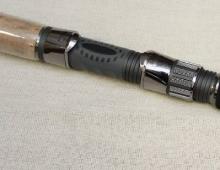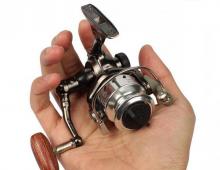Catching rotan in the winter on the pond. Catching rotan on a balancer in winter
The Amur goby, or firebrand, is none other than rotan - a fish with a large head and a huge mouth with several rows of very sharp small teeth. This predator lives no more than seven years.
Fish information
Rotan has amazing survivability. Even the drying up of the reservoir does not cause discomfort to him, and in the conditions of its freezing down to the bottom, this fish, gathering in a lump, grows into the ice. Thus, she survives until spring. Rotan, being a predator, is considered a "headache" for the ecosystem of a particular reservoir. Its fry at first eat small mollusks and plankton, and growing up, they switch to caviar, then to any juveniles, including their own kind.
In small reservoirs, rotan is capable of completely destroying the existing fish resource. It reaches a length of up to twenty-five centimeters. Today, however, such large specimens are a rarity. It bites in any season of the year, however, catching rotan in winter, according to experienced anglers, is especially interesting.
Where to look
The chances of angling large specimens are highest in the first week after freeze-up. Then, slowly, the intensity of the bite begins to subside. At this time, only small fish are caught, and even then rarely and not everywhere. At a time when the ice cover is just beginning to form, flocks of rotans can be found near the coast. But with the growth of its thickness, they begin to move away. And when the ice reaches fifteen centimeters, the flocks together go to the depth. It is there that fishing for rotan occurs in winter.

There are several common ways to find prey. The simplest is drilling up to fifteen holes in the direction from the shore to the center of the reservoir. The distance between them is a maximum of three meters. Catching rotan in winter has its secrets, and one of them is that this fish is extremely lazy. Therefore, she never moves unnecessarily, and even the roar of a drill drilling through the ice cover will not frighten her.
Testing the holes does not take much time. If there is no bite within two minutes, the angler moves on to the next one. The fish begins to be caught immediately, as soon as a flock of rotans appears under the hole.
Angling technique
Every angler has their own tactics. Experienced hunters themselves determine how rattan fishing will take place. In winter, as well as in summer, this fish bites perfectly on a moving bait. Especially if it uses different versions of the game. Some winterers lower the bait to the very bottom, after which they make a sharp rise of several centimeters, then hold the bait motionless at this height for some time. If there is no bite, they take two or three small jerks and stop again. With the onset of frosts, the army of fishing enthusiasts is activated. For a favorite pastime - catching rotan in winter.
Tackle

This predator is caught both in a motionless and active way. The rod can have a variety of designs. It can be both purchased and homemade. The main condition for tackle is the presence of an elastic whip. A winter reel with fifteen meters of fishing line is usually placed on it, the diameter of which should be from 0.2 to 0.15 millimeters. Sometimes with the help of electrical tape, anglers achieve the balance of the rod when they hold it in their hands. Since catching rotan on a balancer in winter involves constant walking from one hole to another, such a balanced tackle is considered the most convenient.
Many choose a nod of the spring type, and quite hard. This is explained by the fact that catching rotan in winter is most common for mormyshka, and quite large, so jewelry play is not expected. In total, the entire tackle assembly weighs no more than three hundred grams.
What to catch
In order for the bite to be good, and the catch to be rich, the fish must be lured. Rotan responds best to protein supplements. However, often anglers start with breadcrumbs and oatmeal, relying on the fact that they will attract many other underwater inhabitants along the way. Some use the most ordinary beef for complementary foods. Fishermen lower a stone into the hole with pieces of frozen meat cut into small ribbons. They say that beef holds rotan thoroughly, so after that, dozens of fish can be pulled out of the reservoir.
Original nozzles
The bloodworm is considered the most successful. But there are winter roads that are excellent at lard fishing, considering this bait not only inexpensive, but also easily accessible. Not a very large piece is enough for a full fishing trip. Rotan pecks at the same piece of fat as a nozzle until it loses its appearance. Only then is it necessary to plant another piece.
Catching rotan in winter for fat, according to experienced fishermen, is very effective. Fishing with such a nozzle as a piece of raw fish meat, including gobies, does not lag behind. However, it is somewhat more difficult to work with it in the cold. It is necessary at all times to ensure that the skin is planted on the sting, and not the meat. Otherwise, the bait can quickly go astray.

Lures
When rotan is active, and this, as a rule, happens on the first ice, it grabs almost everything. But there are moments, and anglers are very well aware of this, when he refuses to peck at all. And here miniature mormyshkas come into play.
Catching rotan in winter with two types of mormyshka proved to be the best. The first is made from a hook with three balls dressed on it, which have fairly large holes. It, according to anglers, should be used when the bite is zero. The second mormyshka looks like a black ball with a crown and a hanging hook strung with multi-colored beads.
Experienced winterers give less preference to the devil, however, with little activity of rotan, it also helps to implement bites. But when the fish captures everything it sees, it makes no sense to use this nozzle, because the predator can swallow it so deeply that after that it will not be possible to either let it go or get the bait out of its mouth.
Spinners
![]()
In an effort to catch larger specimens, experienced anglers try a lot of different rig options. The activity of rotan in winter is somewhat similar to the biting perch. The difference is only in the length of time. If the striped inhabitant of the reservoir is active almost during the entire freeze-up (with the exception of the period of severe deaf winter), then its fellow rotan is best caught on a lure only until the beginning of January.
In shallow lakes, when the ice is still thin, and the oxygen regime has not yet been disturbed, this predator rushes to the lure with enviable constancy. At first glance, catching rotan in winter with a lure contains little intrigue. Indeed, the catch of even a novice angler, who picks up a bait for the first time, often does not differ much from the “harvest” of a winter hunter with impressive experience and experience.
Not bad is catching rotan at night in winter on a horizontal lure. It is somewhat reminiscent of a boat, in which the stern is strongly thickened and the front is pointed. The hole through which the fastener line passes is drilled in the thickened part of the body. Moreover, this is done with such an offset that during the baiting of a massive skin or meat on the hook, the nozzle does not tilt it too much. Otherwise, the whole lure will go down. The fishing line passed through the hole at the end is tied with a fishing knot on the shank of the hook of the fifth-eighth number. In order to easily replace the spinner, you can make a loop so that, after passing it through the mounting hole, throw it on the tip.

Many winter roads use domestically produced bait used for perch fishing. The main thing at the same time is to correctly balance the spinner due to a clearly calculated hole. Of course, such varieties do not have a large thickening at the end that balances the bait, however, catching rotan in winter can also be effective with them. For such a spinner you need a non-thin fishing line. A monofilament with a diameter of 0.15 to 0.17 millimeters is quite suitable. Some anglers use "braid", especially in areas where there are many hooks.
According to even seasoned anglers, fishing this fish brings new sensations every time. If everything goes well, and the hunter manages to run into a flock, then from one hole he can get up to a dozen 300 or 500-gram fish. According to a fairly large number of fans of this predator, even perch fishing is not as exciting as catching rotan in winter on a pond.
It is no secret that in most water bodies of our country, trophy specimens began to come across much less frequently. This applies not only to perch, but also to pike and other predatory representatives of the underwater kingdom. However, this does not apply to rotan in any way. Already in the first or second week after the angler can safely enter the ice, his bite is very pleasing.

Rotan is attractive from a gastronomic point of view. He is a real delicacy. There are no small bones in this fish, and it is easy to clean it, since the scales can be removed with just one stroke of the knife. Fried rotans are "sweeter" than crucians. They are no less tasty in dried form with beer.



